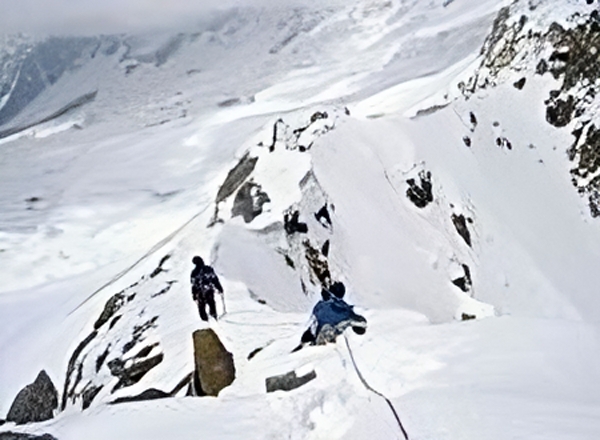CLIMBING YALA PEAK AND NAYA KANGA
CLIMBING YALA PEAK AND NAYA KANGA

Talk With Expert
- +977-1-5591234 / 9851104568
- info@prestigeadventure.com / pdamber@yahoo.com
OVERVIEW
Langtang Valley lies just 30 kilometers north of Kathmandu, near the Tibetan border, below the main ridge of the Himalayas. The valley is dominated by Langtang Lirung (7246m), the highest peak in the area. This trek with optional ascents Yala Peak and Naya Kanga offers a great introduction to Himalayan mountaineering, amid some of the most beautiful scenery in Nepal.
Our trip started with a 6 hour drive to Dhunche. We first passed through subtropical forest, then dense oak, birch and pine forests before the valley opened up to alpine meadows and yak pastures. In spring, these high meadows are covered with a variety of alpine flowers – gentian, violet, edelweis and primrose – and the forests also bloom with rare orchids and rhododendrons. color. Langtang Forest is also famous for its wildlife, including red pandas, Himalayan black bears, wild boars and langur monkeys.
We headed up the valley to Kyangjin, where we camped in a wonderful setting, dominated by the fluted northwest face of Kangchenpo, while Kyangjin Ri offered an excellent view. From Kyangjin we headed up the valley to Yala, a small yersa (summer hamlet). Based here, we had time to hike to the top of Tsergo Ri (5066 m), the highest point of a wide, flat plateau. The views from here are as spectacular as anywhere in the Himalayas, a 360-degree panorama of snow-capped mountains including Langtang Lirung, Pemthang Ri, Langshisha Ri, Dorje Lakpa and Kangchenpo.
Our base in Yala also gave us the opportunity to climb Yala Peak (5500m). It was not technically difficult and allowed us to acclimatize and train well as we climbed Naya Kanga (5844m). The climbing is simple and just involves walking on steep snow slopes of about 30 degrees. The view from the summit is breathtaking: beautiful snow-capped peaks all around and views of Tibet’s mountains, including Shishapangma. Healthy and acclimatized, we moved from Yala to our base camp at Naya Kanga, a camp on the moraine below Kangja La. From here there are great views of the northeast ridge of Naya Kanga, the route we climbed. The climb up is quite simple, although the final snow slope is quite narrow but very interesting for those who are afraid of heights. Once again, the view from the summit was breathtaking, a fitting peak for a spectacular climb.
For those who don’t want to climb Yala Peak and Naya Kanga, there is every opportunity to explore the breathtaking upper Langtang Valley. Our camps were in great locations, the trekking was not difficult and there were many good options for day hikes from our base camp. The walk to and from the Upper Langtang Valley is a “classic” trek in its own right.
We descended from the upper Langtang valley to Syabru before taking another trail, past Sing Gompa, to the sacred lakes of Gosainkund. We crossed Laurebina La (4610m) and returned to Kathmandu passing through the beautiful villages of the Helambu region.
ITINERARY
-
Day 1 Kathmandu to Dhunche
In order to avoid the lengthy dirt road loops, the trail leaves Dhunche and heads east down the hamlet’s main street. It then crosses the Trishuli Khola and follows the road’s contours to the village of Bharkhu. From Bharkhu, the trail ascends sharply until it reaches a hill, where we descend into the Langtang valley. From here, one can see the snow-capped Tibetan mountains to the north and the summit of Langtang Lirung to the east. As we descend, we reach the village of Syabru, which is spread out along a ridge.
-
Day 2 Dhunche to Syabru
The trail leaves Dhunche heading east down the main street of the community, taking one or two shortcuts to skip the lengthier dirt road loops, crossing the Trishuli Khola, and then continuing along the road’s contours to the village of Bharkhu. The trail from Bharkhu reaches a ridge where we enter the Langtang valley after a tough ascent. Views of Tibet’s snow-capped peaks may be viewed to the north and east from here, and Langtang Lirung’s summit can be seen. As we descend, we reach Syabru, a settlement spread out along a ridge.
-
Day 3 Syabru to Lama hote
The primary route to Langtang descends along the ridge, passes through the community, and then keeps going downhill till it reaches the Langtang Khola. Following the river, we ascend through a pristine oak and rhododendron forest that is alive with birdlife. We ascend a difficult trail past Chongong’s lone residence before setting up tent in the wilderness.
-
Day 4 Lama hotel to Langtang village
As we continued climbing, we occasionally saw Langtang Lirung among the trees. At Ghora Tabela [3000m], the road opens into open ground. There was once a resettlement project for Tibetans here, but it is now a Nepalese military post although it has no permanent residents. The trail continues to gently climb and the valley widens, passing several temporary settlements used by ranchers to graze cattle on high pastures during the summer months. There is a monastery that we can visit just before reaching Langtang village, the headquarters of Langtang National Park. The houses in Langtang and neighboring villages are Tibetan-style, surrounded by stone walls surrounding fields of buckwheat, potatoes, wheat, radishes and barley.
-
Day 5 Langtang village to Kyangjin
As the valley widens and the views expand, the trail gradually climbs via small settlements and yak pastures. The trail arrives at the Kyangjin settlement after fording a number of minor streams and moraines. A tiny monastery and a cheese factory run by the government can be found nearby. before arriving at Kyangjin before lunchtime, we’ll have time to acclimate and explore the surroundings.
-
Day 6 Rest day in Kyangjin
a day of relaxation, adaptation, and exploration. Visits to the cheese plant and monastery are close to the village. To get a fantastic perspective of Langtang Lirung and its hanging glaciers, we can hike up the moraine to the north. Alternatively, we can climb Kyangjin Ri, which is located immediately behind the hamlet, for an incredible all-around view.
-
Day 7 Kyangjin to Yala
In order to reach the yersa at Yala, we travel farther up the valley from Kyangjin, ascending above the Langtang Khola and curving around the slope. The peaks of Dorje Lakpa (7000m), Kangchenpo (6400m), and Lonpo Gang (7100m) can all be seen clearly from our camp.
-
Day 8 In Yala
It is a short distance to the peak of Tsergo Ri [5066m] from our tent in Yala. The prayer flags and mani stones that mark the top, the highest point on a wide flat plateau, are at the end of this ‘simple’ walk. 360-degree views of snow-capped mountains, including Langtang Lirung, Kimshun, Yanza Tsenji, Langtang Ri, Pemthang Ri, Langshisha Ri, Dorje Lakpa, Kangchenpo, and Naya Kanga, are breathtaking.
-
Day 9 Climb of Yala peak
We have the chance to climb Yala summit, a glaciated summit to Yala’s northeast, from our base at Yala. The climb is not challenging and offers good preparation and acclimatization for our ascent of Naya Kanga. Being little more than a hike up steep snow slopes of about 30 degrees, the climb is simple. The majority of the climb will include walking roped together up the glacier and will require the use of an ice axe and crampons. With stunning mountain scenery all around and views of the adjacent Tibetan mountains, including Shishapangma, this climb is a fantastic start to mountaineering in the Himalaya.
-
Day 10 Yala to Naya Kanga base camp
Retracing our steps, we head back down the valley to Kyangjin, cross the Langtang Khola, and then take a track that ascends to the Kangja La. A camp on moraines beneath the Kangja La is eventually reached after some difficult scrambling through boulder fields. The campground has excellent views of Shishapangma as well as our ascent path up Naya Kanga.
-
Day 11-12 Climb of Naya Kanga
Two days are allowed for ascent. One day can be used as a rest day before climbing Naya Kanga. An early start will take us to Kangja La before taking a flight of steps to cross the glacier and reach the base of the north-east ridge. This mountain range has long, steep snow climbs with beautiful views on both sides. The last strip of snow is quite narrow and will be great fun for those afraid of heights. The view from the summit is amazing and many famous mountains of Nepal can be identified. The long and steep ascent back to camp would leave us tired but very satisfied with our effort. For those who don’t want to climb Yala Peak and/or Naya Kanga, our base at the head of the Langtang Valley has amazing views, as breathtaking as anywhere in the Himalayas and we have all the time to Explore the upper Langtang valley with many good things. Day hike options from our base camps. .
-
Day 13 To Lama hotel
Retracing our steps from Kyangjin, we travel the Langtang Khola to Langtang hamlet and then to Ghora Tabela. We continue the inclining slope to the Lama Hotel after lunch.
-
Day 14 Lama hotel to Syabru
We keep going back the way we came to Syabru.
-
Day 15 Syabru to Sing Gompa
To reach a ridge, one must make a difficult ascent from Syabru through oak, fir, and rhododendron forests. Only a small fall separates this location from Sing Gompa. A modest cheese business and a Buddhist monastery are also nearby.
-
Day 16 Sing Gompa to Gosaikund
We ascend a ridge from Sing Gompa to reach the main Gosainkund route. There are excellent views of Langtang Lirung across the Langtang valley. Dramatic vistas of Himalchuli, Ganesh Himal, and Manaslu may be seen to the west. The first of three lakes, Saraswati Kund, is reached once the trail eventually leaves the hill and descends. Bhairab Kund, the second lake in the chain, and Gosainkund, the third. This lake is especially revered and a destination for pilgrims in the summer. Shiva is said to have created this lake by using his trident to puncture a glacier in order to get water to satiate his thirst after ingesting poison.
-
Day 17 Gosaikund to Gopte
The trail ascends through rocky terrain after leaving Gosainkund and passes four more tiny lakes before arriving at Laurebina La at 4610m. Then, we do a difficult descent to camp close to Gopte.
-
Day 18 Gopte to Mangan Kharka
We continue to descend the hill, passing herders’ huts, juniper and rhododendron trees, and arriving at a creek before climbing to Tharepati, a cluster of herders’ huts at 3490m. In the direction of Jugal Himal and Numbur in the Solu Khumbu, as well as down into the Helambu valley, the trail gradually descends through a forest of pine and rhododendron from Tharepati.
-
Day 19 Mangan Kharka to Gulphu Bhanjyang
After a brief ascent to cross a ridge, the trail leads through a forest with wonderful views of Numbur, Jugal Himal, and numerous other snow-capped summits. The Tamang village of Gulphu Bhanjyang is reached by descending from Kutumsang after ascending to a pass at 2620 meters. On a ridge with breathtaking vistas that stretches from the Annapurnas and Manaslu in the west to Numbur in the east, we set up camp outside of Gulphu Bhanjyang.
-
Day 20 Gulphu Bhanjyang to Chisopani
Following a short ascent from our tent, it is a short descent to Pati Bhanjyang, a sizable Tamang hamlet with a few stores and a police checkpoint. From here, the ascent to Chisopani and our camp takes two hours.

